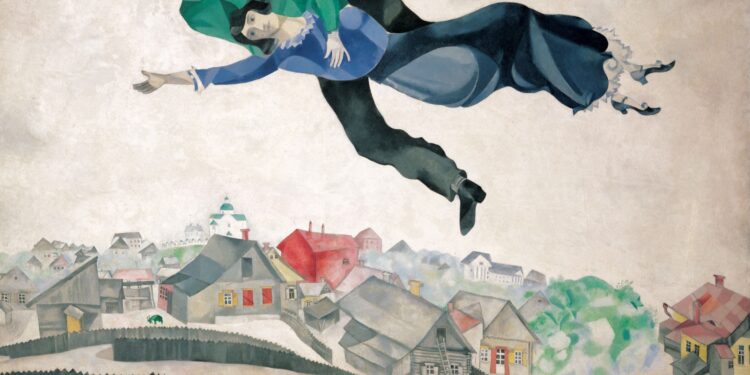Marc Chagall, a luminary of 20th-century art, painted dreams. His canvases are a testament to his unique blend of surrealism, cubism, and fauvism, interwoven with his personal experiences and the folklore of his native Russia. Born Moishe Shagal on July 7, 1887, in Vitebsk, a small town in present-day Belarus, Chagall transcended geographical boundaries to become one of the most celebrated artists of his time.
Chagall’s artistic journey was as colorful as his paintings. His early years were shaped by the vibrant Jewish culture of Vitebsk, which permeated his work throughout his life. After studying art in Saint Petersburg and later in Paris, Chagall developed a style that defied conventional categorization. His paintings often featured fantastical landscapes inhabited by floating figures, animals, and objects, creating a dreamlike ambiance that captivated viewers.
One of Chagall’s enduring themes was love, particularly his love for his wife, Bella. She became a recurring muse in his art, depicted with ethereal grace and tenderness. Their romance was immortalized in works such as “Birthday” and “The Birthday,” where Bella appears as a symbol of love and beauty amidst Chagall’s surreal compositions. Their love story, filled with joy and sorrow, became intertwined with his art, adding depth and emotion to his paintings.
Chagall’s use of color was revolutionary. He painted with bold, expressive strokes, infusing his canvases with a kaleidoscope of hues that danced harmoniously together. His colors were not bound by reality but instead reflected the inner workings of his imagination. Blue, in particular, held special significance for Chagall, symbolizing spirituality, melancholy, and the infinite expanse of the sky. It dominated many of his works, creating a sense of otherworldliness and enchantment.
Throughout his career, Chagall remained deeply connected to his Jewish roots. His paintings often incorporated Jewish symbols, folklore, and biblical themes, offering a modern interpretation of age-old traditions. In works like “The Fiddler” and “The Praying Jew,” he portrayed scenes of Jewish life with reverence and nostalgia, capturing the resilience and spirit of his people.
Despite his avant-garde style, Chagall’s art remained accessible and deeply personal. He had a knack for distilling complex emotions and experiences into simple yet evocative imagery, making his work relatable to people from all walks of life. Whether painting whimsical circus scenes or poignant depictions of war and exile, Chagall imbued his art with humanity and compassion, reminding viewers of the beauty and fragility of the human spirit.
Chagall’s influence extended far beyond the realm of painting. He was a prolific artist, creating masterpieces not only on canvas but also in stained glass, tapestries, and ceramics. His collaborations with renowned architects and designers left an indelible mark on the world of art and architecture, with his stained glass windows adorning cathedrals, museums, and public buildings around the globe.
In 1941, as Europe was engulfed in the horrors of World War II, Chagall and his wife fled to the United States, where they found refuge from the Nazi persecution of Jews. Despite the upheaval and loss he experienced during this tumultuous period, Chagall continued to create, channeling his emotions into art that offered solace and hope to a world torn apart by war.
Marc Chagall passed away on March 28, 1985, leaving behind a legacy that continues to inspire and enchant audiences to this day. His art, with its timeless beauty and universal themes, serves as a reminder of the power of imagination, love, and perseverance in the face of adversity. As we gaze upon his paintings, we are transported into a world of magic and wonder, where colors dance, dreams take flight, and the human spirit soars ever higher.



Recent Comments